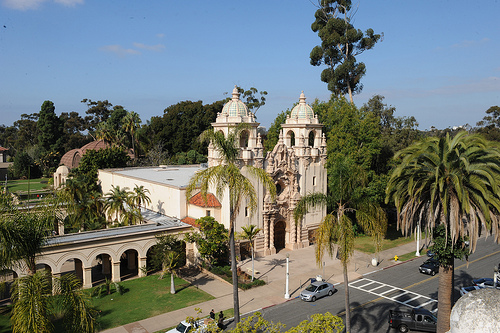By: Jessica Rinaman
Imagine visiting a public park in 15th century Spain. There is green space, canyons, fountains and gardens all around you. In the center of this park, as you walk down a cobble stone path with highly ornamented, flamboyant architectural buildings on either side. Within the buildings of Balboa Park in San Diego you can experience performing arts organizations, cultural centers and 15 unique museums (http://www.bpcp.org/balboa-park). Now imagine going to this location daily for work.  Not a bad gig, right? But how do you capture such historic beauty and sustain it for hundreds of years? That’s what I’m working to understand and accomplish. Each day when I come to this lively park, I work with staff, volunteers and the community to educate them on efficiencies for these museums and cultural centers. We collaborate to sustain the buildings into a highly efficient 21st century. As exhibits change out, so are light bulbs and old, inefficient equipment with newer technologies. Our mission is to advance solutions that will help protect Park resources and strengthen economic viability, while enhancing visitor experience and enjoyment. This shares a similar philosophy to this year’s WMA conference theme, Restore and Rejuvenate Our Natural and Cultural Resources.
Not a bad gig, right? But how do you capture such historic beauty and sustain it for hundreds of years? That’s what I’m working to understand and accomplish. Each day when I come to this lively park, I work with staff, volunteers and the community to educate them on efficiencies for these museums and cultural centers. We collaborate to sustain the buildings into a highly efficient 21st century. As exhibits change out, so are light bulbs and old, inefficient equipment with newer technologies. Our mission is to advance solutions that will help protect Park resources and strengthen economic viability, while enhancing visitor experience and enjoyment. This shares a similar philosophy to this year’s WMA conference theme, Restore and Rejuvenate Our Natural and Cultural Resources.
Museums and cultural centers enrich the lives of their visitors with history, colors, education - the list is endless. But how do we give back to these buildings that give us so much? How do we give back to the collections these buildings hold and visitors come from across the world to see? Through environmental stewardship, of course. At first our education strategy was around awareness, then environmental and economic benefits and finally logistic planning and implementation. We were asking, “What are the environmental challenges for our region?” and “How can museums implement solutions to address these challenges?”. Now we are at a new stage where we can bring the museums’ missions into the conversation to answer a new set of questions including “How can museums be involved in creating new solutions to address these challenges?”. To answer this, we began by asking “How do infrastructure improvements support the museums’ mission?”. Some answers came about organically, which was really cool. We’ve found that this helps to protect the precious collections and enhance the visitor experience. It’s great that environmental stewardship conveniently has multiple benefits within museums rather than trade offs. However, I am still trying to answer the question of new solutions and change driven by museums. I’m ready to gain an education on museums and may the 2012 WMA Annual Conference be my teacher.
I’m excited to attend this year’s WMA Annual Conference in Palm Springs because I have seen the inspiration share by my colleagues after they returned from past conferences. This year we are pleased to have Balboa Park represented once more by an Operations Manager and lighting contractor. It is a proud day when you can listen to someone tell a story you helped create. I hope to take my existing knowledge and apply it to new ideas of visitor engagement, rejuvenated exhibit spaces, preserved collections and of course collaboration. This will help me envision new the role of museums in the cutting edge of sustainability.
I’m especially looking forward to the session: The Contemporary Landscape: Museums and the Environment. As a child, the Carnegie Science Center in Pittsburgh, PA was most likely the first place I heard of environmental impacts from my own daily behaviors. I learned how much water is used in the bath as opposed to the shower and how much impact a small personal change could have. This was a place where a young child could go and understand the complex, highly political issue such as water. Not only did my pre-school self understand the value of water, but I had an action I could take to make a difference. WOW! Now that’s impact. Who needs to watch the movie China Town, why not just go to a museum? That was years ago, so what has changed? Is having low-flow toilets and an exhibit on water conservation enough? I hope to find out with you all shortly!
Jessica Rinaman is a 2012 Wanda Chin Scholarship recipient. She works closely with Partnership members, the City of San Diego, San Diego Gas & Electric and other Park stakeholders to advance solutions that will help protect Park resources and strengthen economic viability, while enhancing staff and visitor experience. Jessica graduated with a degree in Business Administration with a concentration in Marketing from the University of San Diego and is currently enrolled in University of California, San Diego’s, Sustainable Business Practices extension program. Since joining the Balboa Park Cultural Partnership, she has been involved in facilitating over $3 million in energy efficiency upgrades to historic Balboa Park buildings and developing professional education opportunities for Park staff and the public.








Add new comment